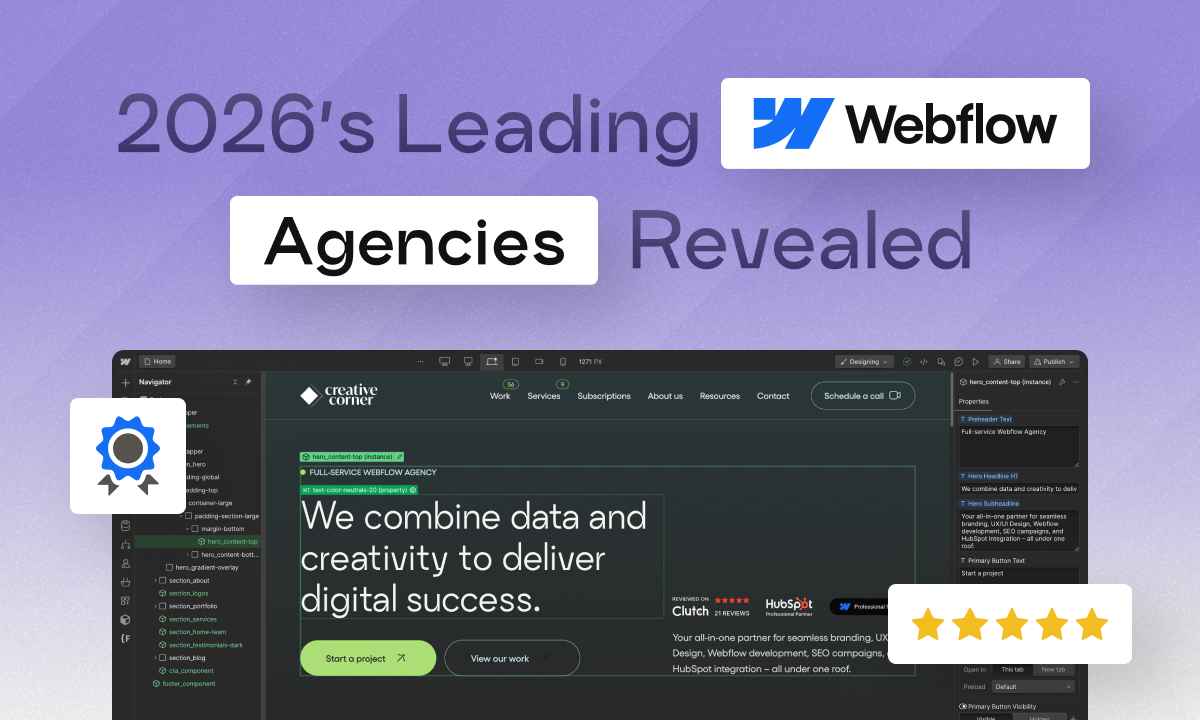Search is changing fast. Pages don’t just rank - they get summarized, cited, and answered by AI. If your brand isn’t feeding that system, someone else is.
Webflow SEO now sits at the center of this shift. If you’ve been asking Is Webflow good for SEO and AI search, this guide gives clear, practical answers - built for 2026 realities, not yesterday’s playbook.
And if you couldn’t catch the New York conference, don’t worry. We’ll walk you through all the new Webflow SEO features they revealed.
Is Webflow Good for SEO and AEO?
Yes. Webflow is purpose-built to support modern SEO, GEO, and AEO strategies (explained below), making it ideal for brands that want to rank high in search engines, be fully understood by AI systems, and get cited across AI chatbots.
With its powerful combination of technical control, performance, and flexibility, Webflow sites achieve maximum visibility on Google and AI-search.
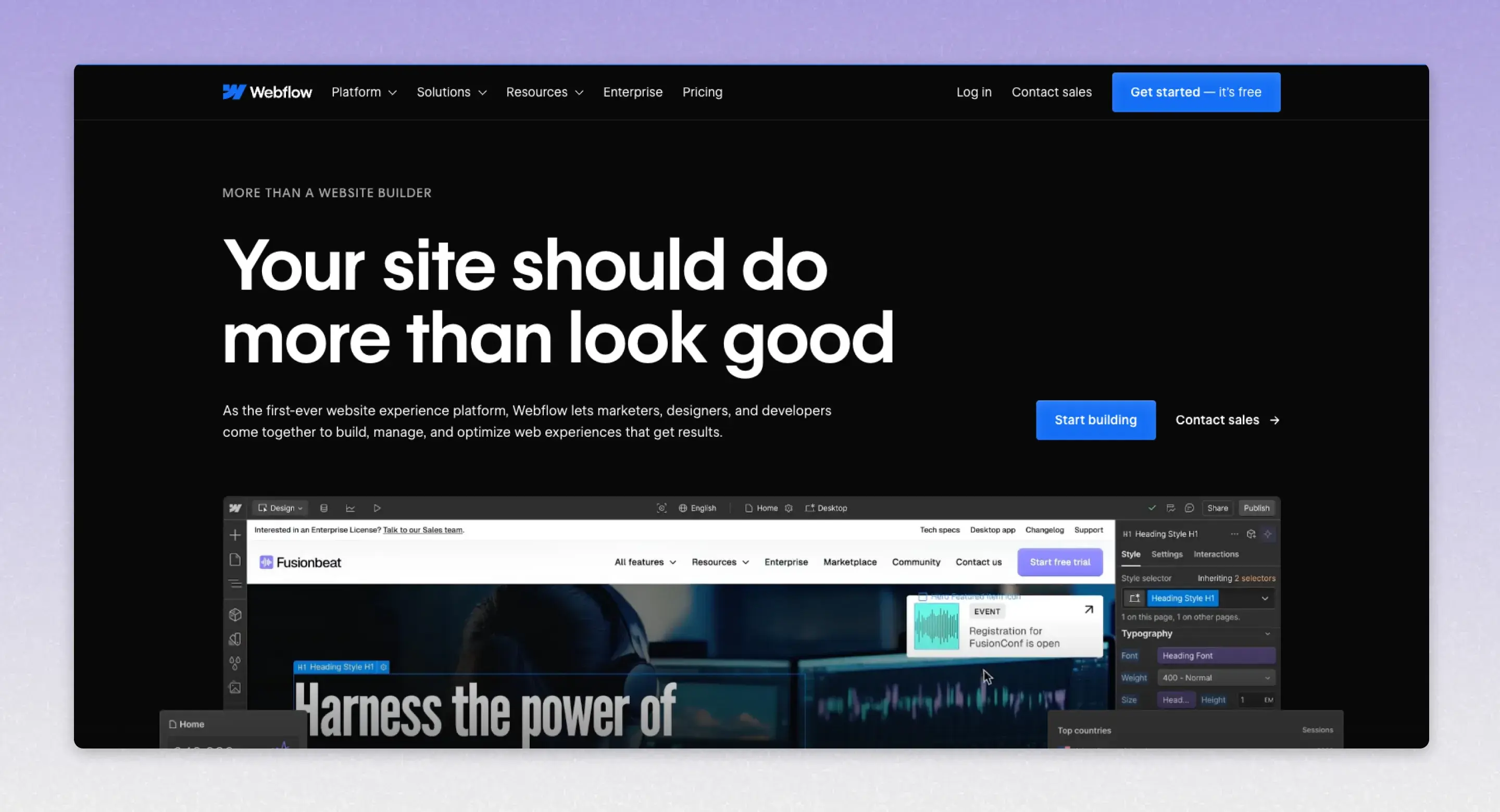
Why Is Webflow a Smart Choice for SEO and AEO Optimization?
For brands and marketing teams, Webflow provides everything needed to future-proof your website for both traditional search and AI-powered discovery:
✅ Clean, crawlable code with semantic HTML
✅ Fast and secure built‑in hosting with global CDN and automatic asset caching by Cloudflare
✅ Full control over meta tags, canonical URLs, and slugs
✅ Manual Schema Markup for rich results and AI visibility
✅ Responsive design and mobile optimization
✅ Scalable content with structured CMS fields
✅ SEO settings for dynamic CMS collection pages
✅ Accessibility features that support WCAG compliance
✅ Analytics and SEO tool integrations
✅ Localization and multi-language support via Weglot and Localise
SEO, GEO, and AEO: What They Mean in 2026
The important thing to point out here is that even though GEO (and AEO) are the new shiny toys, the core rules of traditional SEO aren’t going anywhere.
In 2026, search isn’t just about ranking on Google. It’s about showing up in the places where people ask questions.
That includes traditional search results, as well as AI Overviews, voice assistants, and AI systems that provide answers, including chatbots like ChatGPT and Gemini.
Let’s break down the three layers that matter now:
- SEO ensures your website is discoverable and trusted by search engines. It covers fast-loading pages, clean code, keyword-rich content, and strong internal linking.
- GEO (Generative Engine Optimization) helps AI systems understand and interpret your content. It relies on structured content, schema markup, internal linking, and authoritative external references.
- AEO (Answer Engine Optimization) focuses on how your content is cited and summarized by AI. It emphasizes clarity, structure, and trust signals, making it easier for AI tools to reference your content in answers and summaries.
What is the Difference Between SEO, GEO, and AEO? (Quick Overview)
- SEO – Gets your content ranked in search engines.
- GEO – Helps AI understand your content.
- AEO – Ensures your content is cited or appears in AI answers.
In short:
SEO = Rank | GEO = Understand | AEO = Appear in AI answers ✅

How Is Traditional SEO Different from Webflow SEO?
Webflow SEO refers to professional optimization strategies specifically designed for websites built on Webflow.
Our Webflow SEO experts specialize in SEO and AEO strategies tailored to the platform, helping your website perform strongly in Google search and AI-driven results.
Creative Corner’s Webflow SEO services include market analysis, strategy, AEO-focused content creation, technical SEO, on-page optimization, keyword research, and strategic link building.
Optional Webflow development services bring your vision to life.
Our Webflow developers and designers create websites that are optimized for both users and search engines. If you need a redesign for better UX and a modern UI, our award-winning in-house team can collaborate with yours to build a website your users will love.
Here’s an example of the results our Webflow SEO consultants achieved for one of our clients:

After optimizing our client Wisdom, a top dental billing company in the US, their Webflow website’s average search position soared from 26.1 to 6.2 in just a few months.
This growth came from SEO-optimized content and SEO strategy, the same kind of results we deliver for every Webflow site we work on.
What’s the Distinction Between Optimizing my Webflow site for Google and Optimizing for AI?
As mentioned above, SEO gets you found, AEO gets you quoted.
AEO builds on SEO but adds new layers: clarity, structure, and trust signals that help AI systems understand and reuse your content. It’s not about replacing SEO, it’s about extending it for how people search now.
So, how does Webflow ensure this technical readiness? Let’s take a look.
Is Webflow Ready for AEO in 2026 and Beyond?
Insights from Webflow Conf in New York
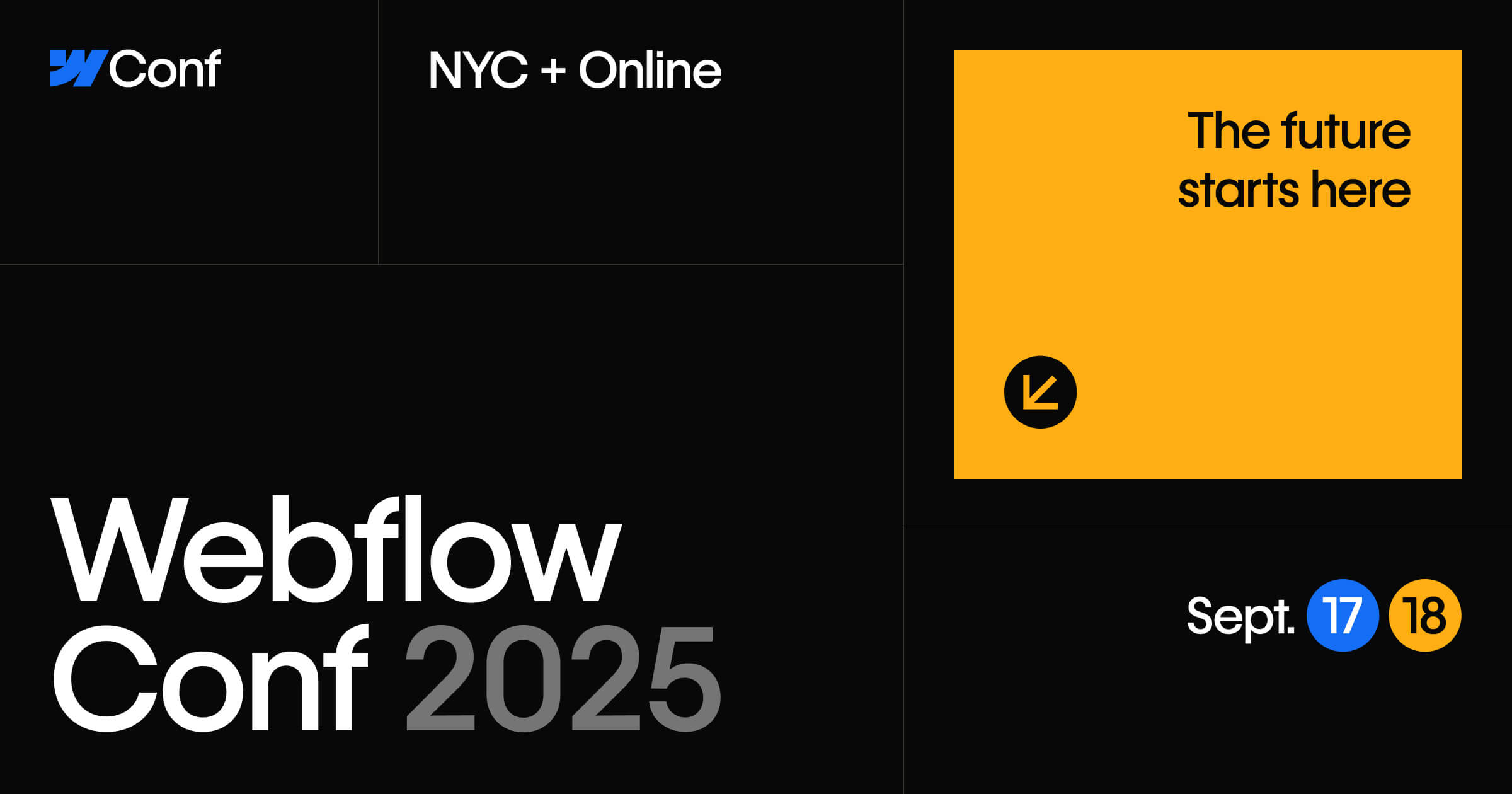
If you have missed Webflow Conf 2025 on September 17–18 at New York’s Spring Studios, here’s a quick recap of the key AEO updates every leader should know.
1. AEO Requirement - Sound Site and Page Level Structure
Webflow Solution - Built-in Best Practices for Site-level Structure, Plus AI-powered Capabilities
Indexing
- Auto-generated XML sitemaps
- Hreflang tags for localized sites
- Llms.txt support
- Robots.txt
URLs
- Flexible URL structure
- 301 and wildcard redirects (granular + at scale)
- Canonical tags
Much of this is built right into the Webflow platform at the site level.
It’s not just about helping humans navigate your site, it’s even more important for AI. A clear hierarchy and logical organization let AI quickly see how different pieces of information are connected as it interprets and answers queries.
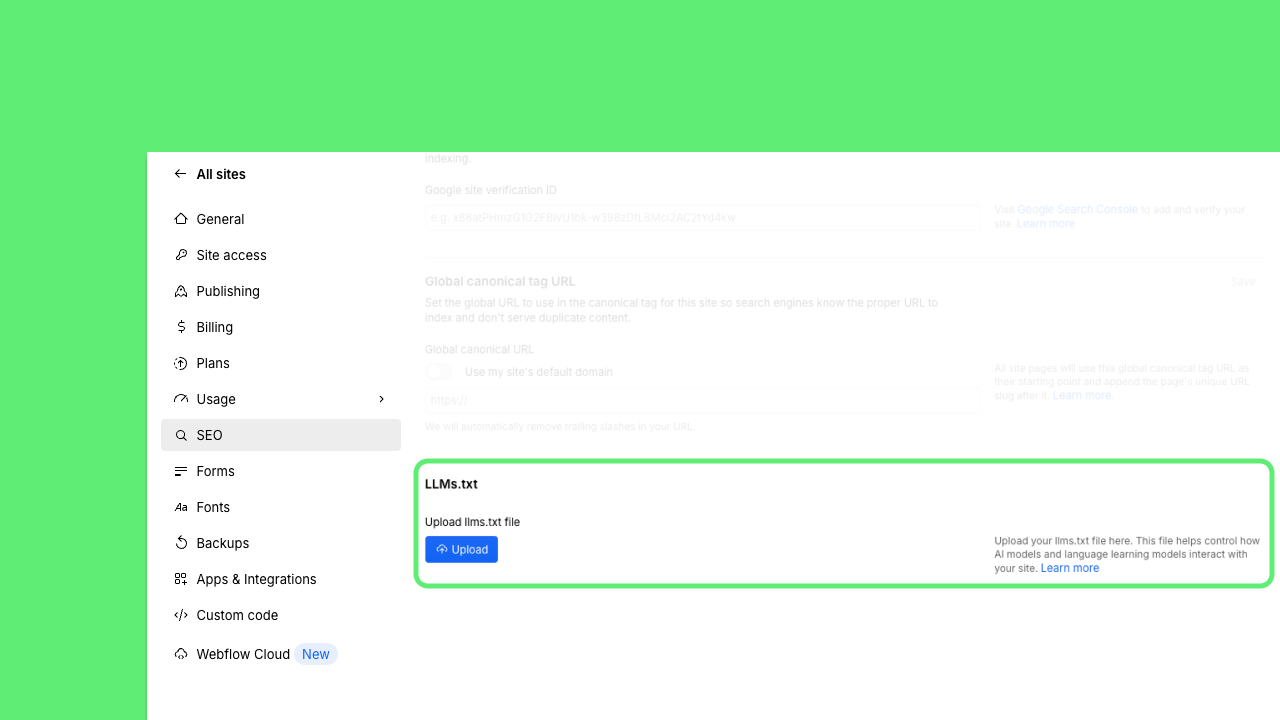
2. AEO Requirement – Fast-Loading Pages
Webflow Solution – Clean Semantic Code Built for Speed
Page speed has always mattered, but it’s even more critical for AI.
Every millisecond counts: slower load times increase processing costs for AI systems, which can affect how often your content is crawled or how it’s prioritized in answers.
Efficiency is everything.
Earlier this year, Webflow unlocked per-page JavaScript and CSS, allowing you to load only the code needed for each page, which reduces file size and improves overall site performance.
This is a critical factor for AEO (GEO) as a fast and efficient site is a key signal of a trustworthy API for agents.
3. AEO Requirement – Site Delivery at Scale, Optimized for Humans and Bots
Webflow Solution – Built-in World-Class Hosting
In other words, your content needs to reach people and AI systems quickly, reliably and securely, everywhere, without a hitch.
Webflow’s hosting takes care of this at scale, delivering fast, secure and dependable performance for both humans and AI.
With other CMSs or custom setups, your team would have to manage hosting, infrastructure and tuning yourself. With Webflow, it is all built in, powered by top-tier Cloudflare hosting, so you do not have to worry about the tech, just the content.
What Are Webflow’s New SEO/AEO Features for 2025–2026?
So, what’s next?
Webflow has added powerful new tools to help your site show up better in Google and AI platforms.
These updates were announced at Webflow Conf 2025 and are designed to make SEO easier, smarter, and more AI-friendly.
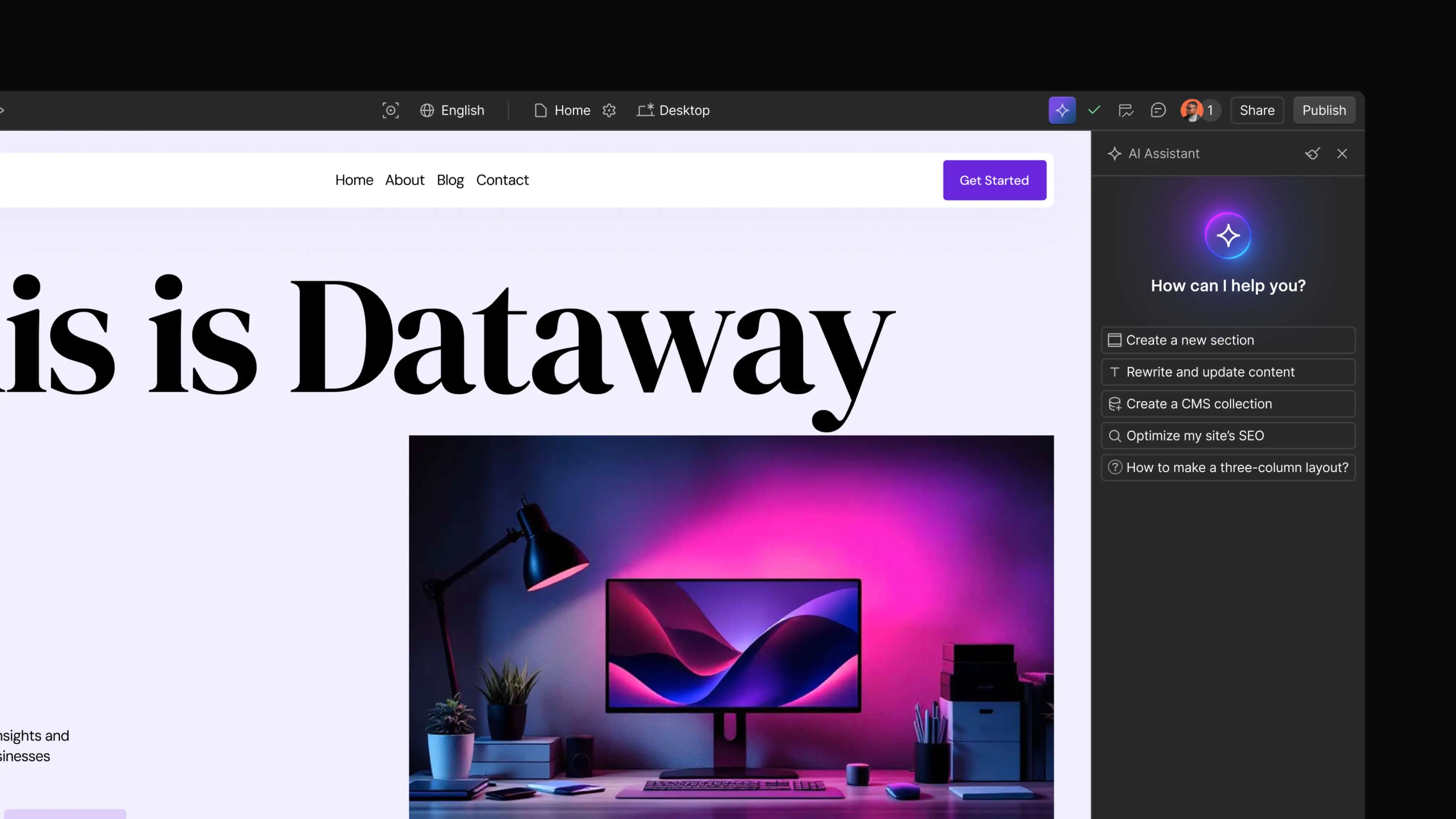
✅ Revamped AI Assistant for SEO/ AEO
You can now use Webflow’s AI Assistant to write key SEO content like:
- Alt text for images in bulk
- Meta titles & description for static and CMS pages
- Schema Markup for static and CMS pages
This saves you time and helps your site get picked up by search engines and AI bots more easily.

✅ Smarter Audit Panel
Webflow’s Audit Panel now uses AI to spot issues before you publish, like:
- Missing alt text
- Schema gaps
- Accessibility problems
Fixing these helps your site rank better and show up in rich results, making technical SEO faster and easier.
✅ Webflow MCP Server
Webflow’s new MCP (Model Context Protocol) server lets AI tools interact directly with your website’s content in a structured way.
This speeds up repetitive tasks like bulk updates, formatting, or content checks, but it doesn’t replace your team’s strategic decisions.
Marketing directors and content teams are still in control: AI can assist, but you set the tone, strategy, and priorities.
✅ Webflow Analyze (Clickmaps & Scrollmaps)
With the Webflow Analyze add-on ($9/month), you can see:
- Where people click
- How far they scroll
- Where they lose interest
This helps you improve user experience (UX) and meet Core Web Vitals - which also helps SEO.
✅ Next-gen Webflow CMS
For AEO optimization, you need a CMS that is flexible, scalable, and programmatically accessible via APIs.
How does this work in Webflow? Webflow’s next-gen CMS (2025) is designed to handle bigger sites, more content, and smarter publishing. It gives marketing teams more flexibility with features like deeper nesting, better data structures, and new APIs for sharing content across different platforms.
It lets you create a structured back-end by modeling content as CMS collections - blog posts, events, team members, or anything you need.
Within each collection, you can add custom fields and define data relationships, creating the foundation AI bots need to understand your content.
Webflow has always offered these capabilities, but handling the volume and scale required for AEO is where the next-gen CMS comes in.
Webflow is unlocking:
- Over 1M CMS Items per site
- 2X the fields and reference fields per Collection
- Up to1 M CMS items per Collection
(Rollout started in 2025).
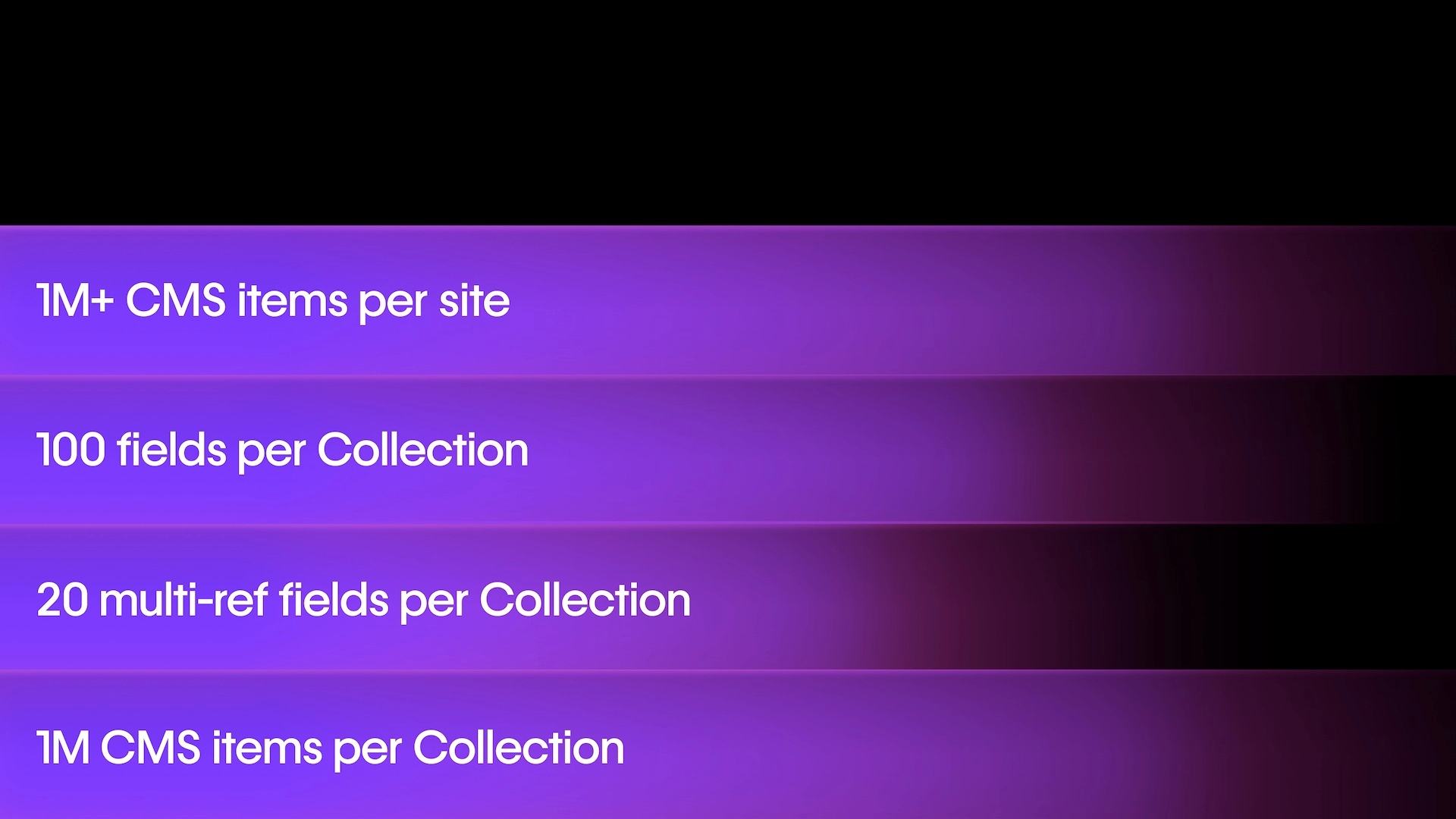
While these updates are important, you want to be confident that your investment, whether for your own business or for your clients, is in a solution that is truly future-proof.
You need a platform you know can scale as your needs grow.
✅Programmatically query CMS content via APIs
Webflow CMS Data is directly accessible via their MACH-certified headless APIs.
MACH-certified means the system is built to be flexible, fast, and easy to connect with other tools, so developers can scale and update websites without limits.
Webflow’s next-gen CMS will unlock:
- Content delivery APIs for all customers (Rollout starts this year, 2025)
- More robust and scalable APIs
🦸♂️🛠️Their goal is to give development superpowers to everyone.
So, the visual tools they are building can enable so many more people to build for the web, but we also know that having scalable, accessible and flexible systems is critical as your needs evolve and change.
Webflow CMS allows a developer or a service powering an AI agent to query your content directly from the backend database.
This means the bot doesn't need to crawl the front end of your website to find a piece of information and instead can ask a direct question and get a clean structured JSON response, which is far more efficient and reliable.
But that’s not all. Webflow is continuing to set this really strong foundation for more robust API capabilities and scale.
What to watch for:
- Redirects require manual setup - important for site migrations and fixing crawl errors
- Advanced schema (like nested JSON-LD) may need custom code embeds
How to Use These New Features for Better SEO and AEO
With Webflow’s new CMS and AI-ready setup, you can now build smarter content structures.
✅ Webflow SEO for Topic Clusters and Content Hubs
Webflow allows you to organize content into topic clusters, which helps search engines and AI tools understand the structure of your site.
This improves visibility in Google and increases the chances of being cited by AI answer engines.
- Connect related CMS pages using references for automatic internal linking
- Maintain consistent meta titles and descriptions across clusters
- Use structured headings and schema to clarify relationships between pages
Do I Need SEO / AEO Optimization for My Webflow Site?
Yes.
Even though Webflow gives you a fast, clean, and technically sound website out of the box, ranking in search engines and being cited by AIs requires more than just a well-built site.
You need continuous SEO/ AEO optimization, strategy and an experienced Webflow SEO Specialists.
If you need support, our Webflow SEO agency help your site compete and win online.
🆚 How Does Webflow SEO Compare to Other Platforms?
Webflow gives you strong control over SEO, structured content, and AI-readiness, making it ideal for teams who want flexibility without relying on plugins.
Many other website builders (like Wix, Squarespace, or Shopify) are simpler but more limited in customization and optimization.
Note: Platform features evolve quickly. Always check the latest capabilities for your plan, especially if AI or large-scale content optimization is important.
🧩Is WordPress or Webflow better for SEO?
When deciding between WordPress and Webflow for SEO, it’s important to consider your specific goals.
Both platforms provide solid SEO features, but the right choice depends on your technical skills and how much customization you need.
Webflow and WordPress both support advanced SEO, but they differ in how those capabilities are delivered.
WordPress offers deep flexibility through plugins and custom code, while Webflow provides a fluid, visual-first experience with built-in performance and structure.
How Do Plugins Compare for SEO in Webflow vs WordPress?
WordPress relies on plugins such as Yoast SEO or Rank Math for detailed control over schema, sitemaps, and audits. This ecosystem provides deep flexibility but can increase complexity and slow down performance if not managed carefully.
Webflow covers most SEO essentials natively, including clean code, structured headings, automatic SSL, and XML sitemaps. It reduces the need for external tools. For additional features, you can use apps such as Semflow, and you can connect Google Search Console directly to monitor performance.
Is Webflow Good for Enterprise SEO and Scalability?
Yes. Webflow supports enterprise-level SEO through CMS Collections, dynamic page creation, and advanced hosting that includes SLAs, SSO, and traffic scaling. It also includes native localization features that make it easier to manage multilingual and international SEO without plugins.
WordPress can also scale effectively for enterprise SEO but typically requires dedicated hosting, caching solutions, and manual security management to achieve the same level of performance.
Which Platform Should Marketing Directors Choose?
If your strategy depends on content depth, custom integrations, and advanced technical SEO, WordPress remains an excellent choice.
If your team values speed, collaboration, built-in SEO structure, and design freedom, Webflow is often the better fit.
Many marketing leaders now choose Webflow for faster publishing, lower maintenance, and higher return on investment.
👁️ How Can You Future-Proof Your Webflow SEO for AI and LLM Search?
To stay relevant in 2026 and beyond, your Webflow site should be optimized for both traditional search engines and AI-powered platforms.
These systems rely on well-structured, trustworthy content to interpret and surface information.
Here’s how to future-proof your Webflow SEO:
• Organize content into clear topic clusters using CMS references and internal linking to help AI and search engines understand relationships between pages.
• Use semantic HTML and additional schema markup such as FAQPage, Article, and Organization to make content machine-readable and support citations in AI-generated answers.
• Maintain consistent metadata across related pages to reinforce topical authority and clarity for search engines and AI systems.
• Publish answer-focused content with headings formatted as questions, long tail keywords, lists, tables, and FAQs that match how users ask questions and how AI presents answers.
• Monitor Core Web Vitals, mobile performance, and accessibility to ensure technical standards are met, which benefits both SEO and AI discoverability.
• Integrate structured external references when possible to increase trust signals and improve chances of being cited by AI systems.
After finishing your blog posts, ask yourself:
- Does this article match the search intent?
- Are relevant keywords naturally included throughout?
- Are header tags and meta descriptions properly optimized?
- Did I optimize my ALT tags and images?
- Does the post cover the topic thoroughly?
- Is the content original and valuable?
- Does it provide insights, data, quotes, or other useful information?
- Are there relevant visuals like images, videos, or infographics?
- Will readers take away at least one actionable insight or lesson?
Keep revising your post until you can confidently answer “Yes” to all of these.
Following these steps strengthens your SEO, GEO, and AEO strategies, helping your Webflow site rank in search results, get cited in AI answers, and remain relevant in evolving search environments.
Is Webflow good for SEO / AEO - Our Expert Verdict
Webflow is not just good for SEO and AEO - it’s strategically powerful when paired with GEO and AEO best practices.
You get clean code, excellent performance, and full control over how your brand appears in search results and AI-generated answers.
And if you’re looking for Webflow SEO experts, you know where to find them.







